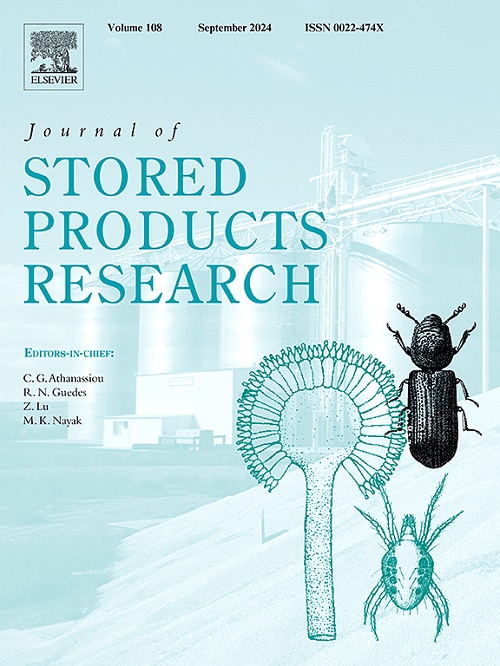利用机器学习方法和人工神经网络评估和预测储存条件和包装材料对水稻物理性质的影响
IF 2.7
2区 农林科学
Q1 ENTOMOLOGY
引用次数: 0
摘要
稻谷的整体品质受贮藏条件和环境的影响。为了探索这一概念,本研究在6个月内考察了储存条件和袋材对水稻籽粒物理性质和品质的影响。对黄麻袋(JB)、聚丙烯编织袋(PWB)和穿孔聚丙烯编织袋(P-PWB) 3种粮食储藏袋在仓库(WH: 25±2°C)和冰箱(R:4±1°C)湿度为18%、14%和12%的条件下进行贮藏试验。质量评价包括真菌定植、白度、裂纹率、硬度、颜色、破碎率和发芽率的评价。利用人工神经网络(ANN)和优化模型来预测和改进储藏时间、储藏条件和袋材对水稻物理品质的影响。结果表明,在4℃、含水量为12%的条件下,将水稻用黄麻袋或P-PWB储存,可以抑制真菌的生长,并保持稻米品质。P-PWB显示在所有湿度水平,温度和储存时间下的最低变色百分比,证明其优越的保护作用。对于较短的储存,P-PWB是理想的保存晶粒硬度和减少破损。此外,在4°C和12% MC下的P-PWB在长时间储存期间非常有效地保持白色和整体视觉质量。皮尔逊相关分析显示,裂纹比和破碎率之间存在很强的正相关关系,这强调了在裂纹增加破碎的情况下保持晶粒完整性的必要性。主成分分析(PCA)发现,裂纹率、变色和真菌污染是影响籽粒整体品质的关键因素,发芽率、白度和硬度起辅助作用。此外,将人工神经网络(ann)应用于评价和预测储藏环境和袋材对水稻品质的影响,为改进食品保鲜策略提供了一条有前景的途径。本文章由计算机程序翻译,如有差异,请以英文原文为准。
Evaluating and predicting the impact of storage conditions and packaging materials on the physical properties of paddy rice using machine learning approaches and artificial neural networks
The overall quality of paddy rice grains is affected by storage conditions and the environment. To explore this concept, the study examines the influences of storage conditions and bag materials on paddy rice grains' physical properties and quality over 6 months. Three types of storage bags, including Jute bags (JB), Polypropylene woven bags (PWB), and Perforated-polypropylene woven bags (P-PWB), were tested under warehouse (WH: 25 ± 2 °C) and refrigerator (R:4 ± 1 °C) conditions for storing grains at moisture levels of 18, 14, and 12 %. The quality assessment included the evaluation of fungal colonization, whiteness degree, crack percentage, hardness, color, broken percentage, and germination rate. More so, Artificial Neural Networks (ANN) and optimization models were utilized to predict and improve the impact of storage time, storage conditions, and bag materials on the physical qualities of paddy rice. The findings indicate that storing paddy rice at 4 °C with 12 % moisture content in jute bags or P-PWB limits fungal growth and preserves rice quality. P-PWB showed the lowest discoloration percentages across all moisture levels, temperatures, and storage durations, demonstrating its superior protection. For shorter storage, P-PWB is ideal for preserving grain hardness and reducing breakage. Additionally, P-PWB at 4 °C and 12 % MC is highly effective in retaining whiteness and overall visual quality during prolonged storage. Pearson correlation analysis revealed a strong positive correlation between crack ratio and broken percentage, emphasizing the need to maintain grain integrity as cracking increases breakage. Principal Component Analysis (PCA) identified crack ratio, discoloration, and fungal contamination as key factors affecting overall grain quality, with germination, whiteness, and hardness playing supporting roles. More so, integrating Artificial Neural Networks (ANNs) into evaluating and predicting the influence of storage environments and bag materials on paddy rice quality offers a promising approach to enhancing food preservation strategies.
求助全文
通过发布文献求助,成功后即可免费获取论文全文。
去求助
来源期刊
CiteScore
5.70
自引率
18.50%
发文量
112
审稿时长
45 days
期刊介绍:
The Journal of Stored Products Research provides an international medium for the publication of both reviews and original results from laboratory and field studies on the preservation and safety of stored products, notably food stocks, covering storage-related problems from the producer through the supply chain to the consumer. Stored products are characterised by having relatively low moisture content and include raw and semi-processed foods, animal feedstuffs, and a range of other durable items, including materials such as clothing or museum artefacts.

 求助内容:
求助内容: 应助结果提醒方式:
应助结果提醒方式:


